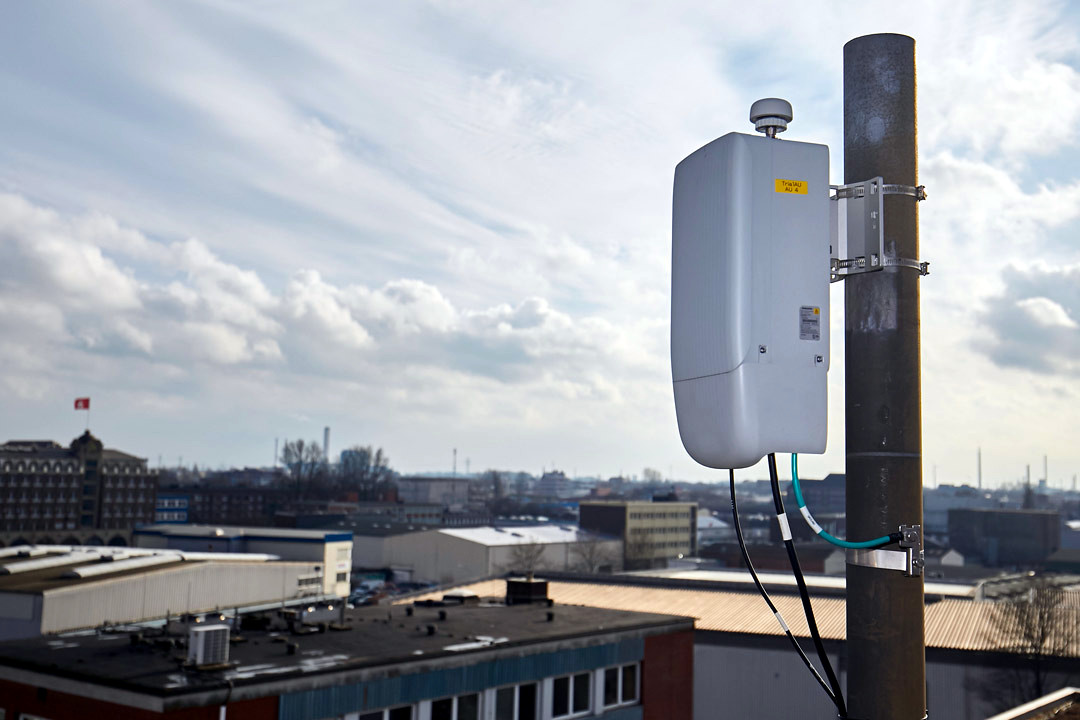Sponsors Article
Frequency allocation in the 26 GHz band has startet
Soon to be in widespread use in Germany? Antenna from Telefónica / O2’s 5G FWA field trial in Hamburg. (Source: Rolf Otzipka / Telefónica)
The German Federal Network Agency has now put spectrum in the range above 6 GHz out to tender for the first time, in what is known as Frequency Range 2 (FR2). Applications for up to 800 MHz of bandwidth can be submitted here. The first deadline expires on March 31, 2021.
So now the time has come in Germany, too: data communications is moving into the millimeter wave range. Without much announcement, the German Federal Network Agency (BNetzA) launched at the turn of the year the allocation of bandwidth in the 24.25 to 27.5 GHz spectrum, known as the 26 GHz band. Industry 4.0 and (I)IoT applications are thus possible, as are private 5G campus networks or Fixed Wireless Access (FWA) as a replacement for DSL.
According to the application documents, interested parties must specify the desired bandwidth and the area used. Allocation is done in each case as an individual administrative act, since it is necessary to coordinate future use with existing radio services, according to the BNetzA.
Actually no limits…
In the current allocation procedure, neither spatial limits nor bandwidth restrictions are envisaged. The authority assumes that the requested bandwidths will be a maximum of 800 MHz based on currently available equipment parameters.
However, it has certainly put a stop to spectrum hoarding: The more bandwidth is requested, the more detailed the need must be justified. The same applies if a specific spectrum is to be allocated. Likewise, if more than 800 MHz were to be requested at a later date, a detailed spectrum usage concept would have to be presented.
Another safeguard against unnecessary spectrum blocking is the “use it or lose it” principle: use must commence within 12 months, otherwise the allocation can be revoked. In case of cross-plot use, the authority requires information on progress after 6, 9 and 12 months.
In addition, BNetzA wants to ensure that property owners who have not yet received frequencies for campus networks – for example in the 3.7 GHz band – are not simply passed over in the allocation process. If the frequency ranges applied for would result in less than 800 MHz of residual bandwidth remaining, it wants to give property owners the opportunity to submit a corresponding application for their part. Reservations for later applications, on the other hand, are excluded.
The associated administrative regulation also describes the principles for protecting neighboring radio networks, as well as the radio services to be coordinated, in particular directional radio, astronomical applications and satellite communications.
Mandatory information
The following application documents are required for requests for spectrum in the 26 GHz band:
- Application for area allocation or determination of site-specific usage parameters of base stations;
- Frequency usage concept;
- Confirmation of expertise, capability and reliability;
- Concluded operator agreements;
- Excerpt from the commercial register.
Information on the technical conditions, the preparation of operator agreements and the frequency usage concept as well as the radio sites to be protected can also be found in the administrative regulation. All applications for allocation received by March 31, 2021, will benefit from first-day privilege: they will be considered to have been submitted at the same time. The mail address to which applications should be sent is 226.lokalesbreitband@bnetza.de.
Fee formula
The fee formula for the allocation of local frequencies in the 26 GHz band follows the same system as the fee calculation for the allocation of campus licenses in the 3.7 GHz band. However, with a significantly lower multiplication factor (0.63 instead of 5.0), which, according to the BNetzA, reflects the different bandwidth requirements and propagation conditions. The specific formula is:
Charge (in euros) = 1000 + B x t x 0.63 x (6 x a1 + a2).
For explanation:
- 1000 indicates the base amount in euros,
- B indicates the bandwidth in MHz (min. 50 MHz),
- t corresponds to the term of the allocation in years (e.g. 15 years),
- a is the area in square kilometers, with a differentiation between settlement and traffic areas (a1) and other areas (a2).


